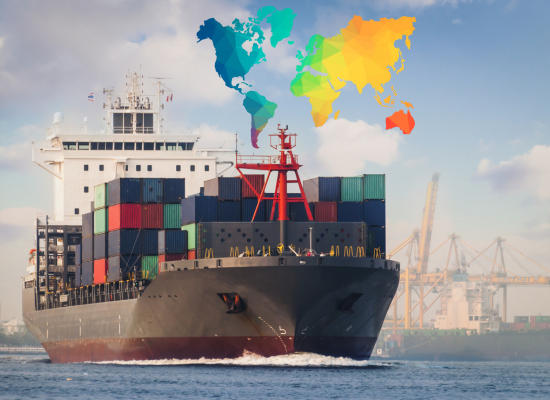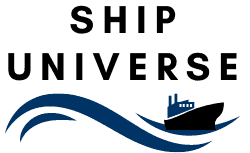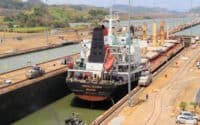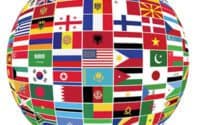The Top 12 Most Profitable Shipping Routes Worldwide

The most profitable shipping routes are crucial arteries of commerce, heavily relied upon to transport everything from everyday consumer goods to vital energy resources. These routes are not just water paths; they are economic lifelines that impact global supply chains and influence trade dynamics. As we explore the top twelve routes, we see a reflection of global economic priorities and the logistical demands of modern trade.
* Please send feedback/suggestions to editor @ shipuniverse.com
1. Asia-Europe Route: The Trade Superhighway
Overview
This route links the vast manufacturing landscapes of Asia with the consumer-heavy markets of Europe. It is one of the busiest and most critical shipping lanes in the world.
Key Ports
Major ports facilitating this route include Shanghai, Singapore, and Rotterdam, acting as crucial nodes in global trade.
Main Goods
The route primarily transports electronics, clothing, and other manufactured goods.
Why It’s Profitable
High trade volume and strategic relevance ensure robust profitability. The route benefits from continuous shipping advancements and efficiencies in logistics.
2. Trans-Pacific Route: The Economic Bridge
Overview
Connecting North America with Asia, this route is a vital conduit for trade between the eastern Asian coasts and the western shores of the U.S. and Canada.
Key Ports
Critical ports include Los Angeles, Long Beach, and Busan, which handle some of the highest container traffic globally.
Main Goods
Key commodities include electronics, automobiles, and a wide range of consumer products.
Why It’s Profitable
The route’s profitability is driven by high demand, especially during peak retail periods in the U.S. like Black Friday and Christmas. Challenges such as tariffs are offset by high volume and the essential nature of timely deliveries.
3. North America-Europe Route: The Atlantic Link
Overview
This historic route connects North American ports like New York and Norfolk with European hubs such as Hamburg and Antwerp.
Key Ports
It utilizes well-established ports that are strategically positioned to facilitate transatlantic trade.
Main Goods
The diverse cargo includes agricultural products, automotive parts, and pharmaceuticals.
Why It’s Profitable
Stable trade relationships and a steady demand across various sectors ensure ongoing profitability. Continuous improvements in maritime technology and routing also enhance its efficiency and appeal.
4. Middle East-Asia Route: The Energy Express
Overview
This route is crucial for the transport of oil and gas from the Middle East to energy-hungry markets in Asia, especially China and India.
Key Ports
Important ports include Dubai’s Jebel Ali, Saudi Arabia’s Ras Tanura, and Singapore.
Main Goods
Primarily oil, natural gas, and derivatives.
Why It’s Profitable
The critical nature of energy resources, coupled with the high demand in Asian economies, ensures high profitability. The route’s importance has led to significant investments in maritime infrastructure and technological advancements.
5. Panama Canal Route: The Shortcut Connector
Overview
Connecting the Atlantic and Pacific oceans, this route is a vital shortcut for maritime traffic between the East Coast of the U.S. and the West Coast of South America, as well as Asia.
Key Ports
Key ports include New York on the Atlantic side and Long Beach on the Pacific side.
Main Goods
This route is diverse, handling everything from agricultural products to manufactured goods.
Why It’s Profitable
The Panama Canal saves ships significant time and fuel costs compared to the longer route around the southern tip of South America. The tolls ships pay to pass through the canal contribute significantly to its profitability.
6. Suez Canal Route: The Europe-Asia Gateway
Overview
This essential route connects Europe with Asia, bypassing the need for a lengthy and costly journey around Africa via the Cape of Good Hope.
Key Ports
Significant ports include Rotterdam in the Netherlands and Singapore.
Main Goods
It carries a wide range of goods, including oil, machinery, and consumer products.
Why It’s Profitable
The Suez Canal is strategically crucial, offering a faster passage between the North Atlantic and the Indian Ocean. The fees for transiting the Suez Canal are a major source of revenue, ensuring its profitability despite regional instabilities.
7. Northern Sea Route: The Arctic Pathway
Overview
This emerging route runs along the northern coast of Russia, from the Kara Sea to the Bering Strait, significantly reducing the transit time between Europe and Asia compared to traditional routes through the Suez or Panama Canals.
Key Ports
Significant ports include Murmansk in Russia and Rotterdam in the Netherlands.
Main Goods
Primarily energy products like natural gas and oil, as well as minerals and metals.
Why It’s Profitable
The Northern Sea Route is becoming more accessible due to climate change and melting ice, reducing shipping times and costs. It is particularly profitable for Russian energy giants exporting to Asian markets, offering a quicker alternative to southern routes.
8. South China Sea Route: The Busy Southeast Corridor
Overview
One of the busiest maritime routes in the world, it cuts through the South China Sea, connecting East Asia with Southeast Asia, the Indian Ocean, and beyond.
Key Ports
Key ports include Hong Kong, Singapore, and Port Klang in Malaysia.
Main Goods
Electronics, clothing, toys, and a multitude of consumer products flow through this route.
Why It’s Profitable
The high traffic volume and its position as a critical link for manufacturing exports from China and other Asian economies ensure constant demand and profitability. The route’s centrality in regional trade networks makes it indispensable.
9. West Africa to Europe Route: The Resource Lane
Overview
This route links the resource-rich countries of West Africa with the European market, primarily transporting raw materials and agricultural products.
Key Ports
Important ports include Lagos in Nigeria and Antwerp in Belgium.
Main Goods
Oil, cocoa, precious metals, and other raw materials are predominant on this route.
Why It’s Profitable
The export of high-demand commodities like oil and precious metals to Europe ensures steady profitability. European investments in African infrastructure and trade agreements also enhance the route’s efficiency and economic viability.
10. Australia to Asia Route: The Commodities Channel
Overview
This route serves as a vital link between Australia and the bustling markets of Asia, particularly China, Japan, and South Korea.
Key Ports
Key ports include Port Hedland and Brisbane in Australia and Shanghai in China.
Main Goods
Mainly iron ore, coal, and agricultural products like wheat and beef.
Why It’s Profitable
Australia is a leading exporter of minerals and agricultural products, which are in high demand in Asia. The steady flow of these essential commodities ensures high profitability for the shipping companies involved.
11. Brazil to China Route: The Iron and Grain Trail
Overview
This route is crucial for transporting bulk commodities from Brazil to China, the world’s largest consumer of raw materials.
Key Ports
Important ports include Santos in Brazil and Tianjin in China.
Main Goods
Iron ore and soybeans dominate this route.
Why It’s Profitable
China’s insatiable demand for iron ore for steel-making and soybeans for consumption makes this route highly profitable. The long-haul nature of the voyage is offset by the high volume and essential nature of the goods transported.
12. US Gulf Coast to Europe: The Energy Exchange
Overview
Linking the energy-producing Gulf Coast of the United States with energy-consuming countries in Europe, this route is critical for transatlantic trade.
Key Ports
Major ports include Houston and New Orleans in the USA and Rotterdam in the Netherlands.
Main Goods
Primarily oil and gas, as well as petrochemical products.
Why It’s Profitable
The export of energy resources from the US, particularly in the wake of shale gas and oil production booms, to energy-hungry European markets ensures consistent demand and profitability. Technological advancements in shipping and the strategic nature of energy trade further enhance profitability.
The twelve most profitable shipping routes we’ve discussed illustrate the diversity and importance of maritime logistics. These routes facilitate economic activity across continents, significantly impacting global trade. As global needs and technologies evolve, these routes will adapt, continuing to play a key role in economic development and international commerce. Understanding these routes helps us grasp the intricate network of trade that underpins much of our world’s economy.

Do you have any feedback or additional insights? Please reach out to editor @ shipuniverse.com




